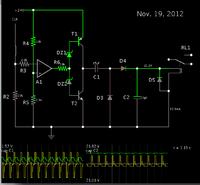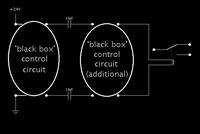sr_raval
Advanced Member level 4
Hello Brad,
As i told you in my previous post i have tried to simulate this circuit on TINA simulator but i am not frequent user of this tool so couldnt simulate the circuit.
However, i have made few changes in circuit.
Our main goal is to design a circuit in sucha way that when any of the component get short or open relay should not energize (it should stay connected at NC position)
In this attached circuit I found following error, help to resolve this issue.
1) When R3 Short Relay energize
2) When R13 Short Relay energize
3) When R2 open Relay energize
4) When R11 open Relay energize
5) When R12 open Relay energize
6) When R13 open Relay energize
7) When C1 Short Relay energize
8) When C2 Short Relay energize
9) When C3 Open Relay energize
10) When DZ3 Short Relay energize
11) When T4(C-E) short Relay energize
12) When T4(B-C) short Relay energize
13) When outout of A2 op-amp short with inverting inverting input of A2 op-amp Relay energize
As per UL in above all condition relay should deenergize.
I am confuse what to do to resolve all this issues?
Is there any other way to resolve this issue by adding or subtracting few components from this circuit?
In this Circuit i have removed D4 & D5 because it doesnt affect the result, wheather its there or not.
Atleast circuit should resolve all those issues on any clock frequency and 24VDC voltage, i dont require tolerence in voltage range.
Look forward to hear from you soon.
As i told you in my previous post i have tried to simulate this circuit on TINA simulator but i am not frequent user of this tool so couldnt simulate the circuit.
However, i have made few changes in circuit.
Our main goal is to design a circuit in sucha way that when any of the component get short or open relay should not energize (it should stay connected at NC position)
In this attached circuit I found following error, help to resolve this issue.
1) When R3 Short Relay energize
2) When R13 Short Relay energize
3) When R2 open Relay energize
4) When R11 open Relay energize
5) When R12 open Relay energize
6) When R13 open Relay energize
7) When C1 Short Relay energize
8) When C2 Short Relay energize
9) When C3 Open Relay energize
10) When DZ3 Short Relay energize
11) When T4(C-E) short Relay energize
12) When T4(B-C) short Relay energize
13) When outout of A2 op-amp short with inverting inverting input of A2 op-amp Relay energize
As per UL in above all condition relay should deenergize.
I am confuse what to do to resolve all this issues?
Is there any other way to resolve this issue by adding or subtracting few components from this circuit?
In this Circuit i have removed D4 & D5 because it doesnt affect the result, wheather its there or not.
Atleast circuit should resolve all those issues on any clock frequency and 24VDC voltage, i dont require tolerence in voltage range.
Look forward to hear from you soon.



